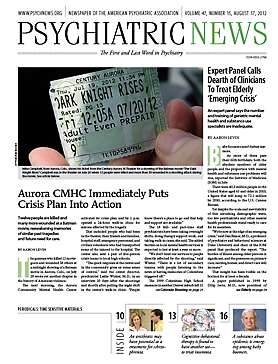Ronald Kessler, Ph.D., a professor of health care policy at Harvard Medical School, isn’t easily astonished by mental illness. He headed up the National Comorbidity Survey Replication (Psychiatric News, July 15, 2005). But the outcome of his most recent national mental disorder prevalence study—of intermittent explosive disorder (IED) among adolescents—came, he told Psychiatric News, “as a complete surprise.”
“I was surprised by the large proportion of adolescents in the United States who meet criteria for IED,” he admitted. “It is one of the most common of all DSM-IV disorders among adolescents. …”
In essence, Kessler and his team found in their national sample of some 6,500 adolescents in which they used a modified version of the Composite International Diagnostic Interview, that 8 percent met DSM-IV criteria for lifetime IED. The disorder is characterized by recurrent episodes of aggression involving violence or destruction of property out of proportion to a provocation or precipitating stressors and is not explained by another mental disorder or by substance abuse.
Still other provocative findings emerged from the study, which was published online in the July Archives of General Psychiatry.
IED had an early age of onset, on average at age 12, and was highly persistent, as indicated by 80 percent of lifetime cases meeting 12-month criteria for IED.
Moreover, every other time a youngster with lifetime IED experienced an outburst of anger, he or she injured someone enough that that person needed medical attention.
While more than one-third of adolescents with current IED received treatment for emotional problems in the year before the diagnostic interview, only 7 percent were treated specifically for anger.
And whereas boys were more likely than girls to engage in anger outbursts, the prevalence of IED did not differ between boys and girls. Kessler said he cannot explain this apparent contradiction. But “speculatively,” he said, “it’s likely that there are a lot of reasons why people have anger attacks. Some of them involve other mental disorders, like conduct disorder, bipolar disorder, and substance use disorder. Others occur for reasons unrelated to mental disorders. And then there are the minority of anger attacks that are due to IED.”
The study results have clinical implications, Kessler believes. “I would like clinicians to know that an awful lot of adolescents have anger attacks who are not being treated,” he said. “And if effective treatments exist, there should be efforts to get a higher proportion of these youth into treatment.”
Yet when Psychiatric News asked Emil Coccaro, M.D., chair of psychiatry at the University of Chicago and an expert on IED treatments, whether there are any evidence-based treatments for IED in adolescents, he replied: “Yes, but there’s not that much data in this regard, partly because child and adolescent psychiatrists don’t use IED as a diagnosis that often, given that there are other disruptive behavior disorders that they can give as a diagnosis.”
David Fassler, M.D., a child and adolescent psychiatrist who is a clinical professor of psychiatry at the University of Vermont and APA’s treasurer, noted that “There is no specific or ‘approved’ treatment for IED. In general, treatment would be individualized to the person.… Psychotherapy will generally be the key, often augmented by medication.”
For example, Fassler said, cognitive-behavioral therapy can help youth with the disorder identify situations or behaviors that may trigger an aggressive response and teach them how to manage their anger and control inappropriate responses with relaxation exercises. Medications that may help include antidepressants, anticonvulsants, antianxiety agents, and mood regulators, he said.
The study was funded by the National Institutes of Health, the Substance Abuse and Mental Health Services Administration, the Robert Wood Johnson Foundation, and the John W. Alden Trust.


